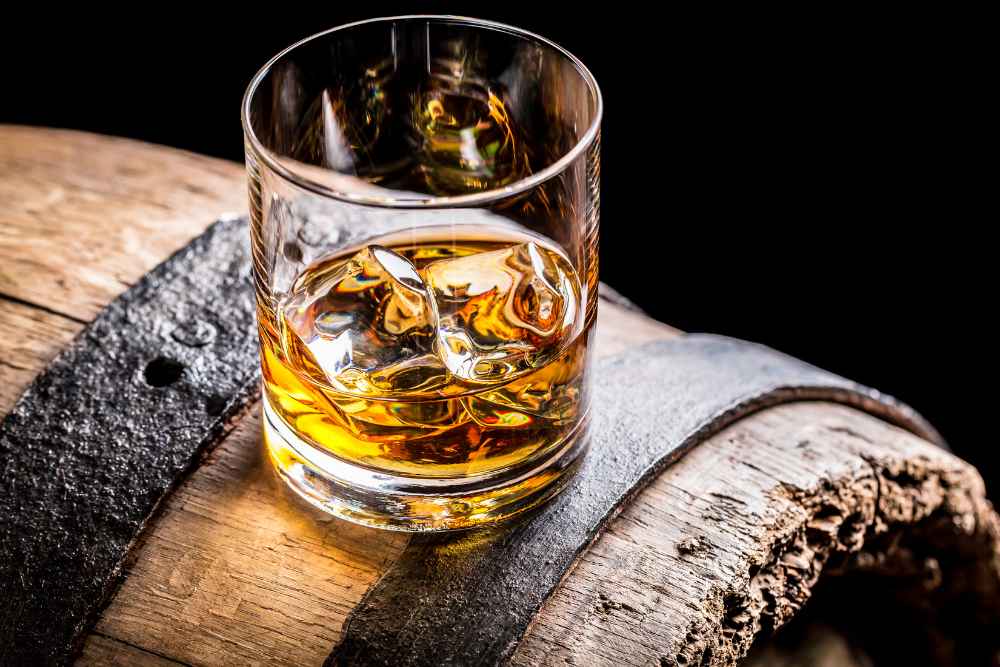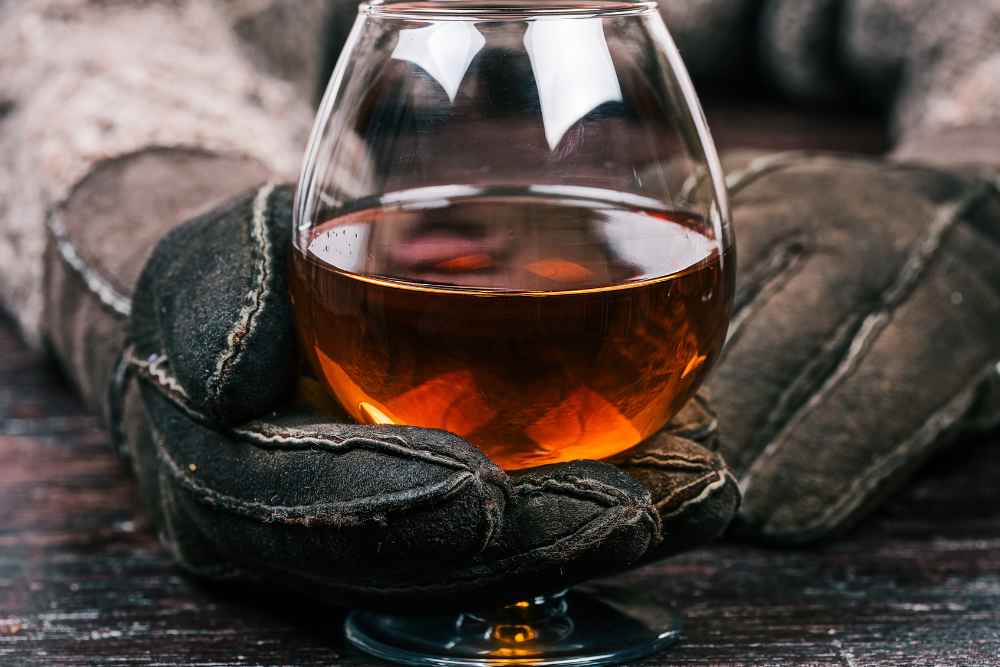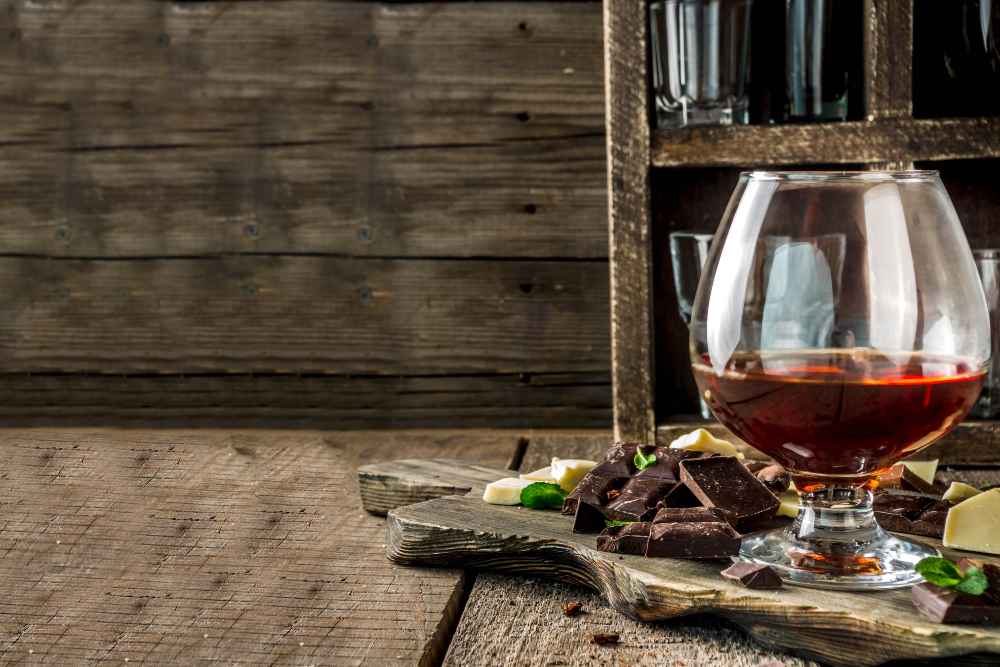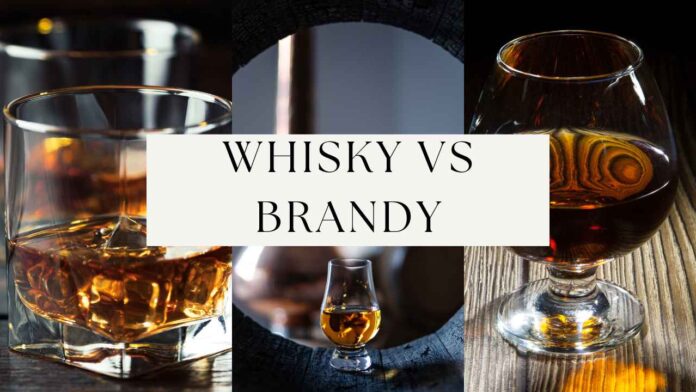This page may contain affiliate links. Please see our Disclaimer for more information. Always drink responsibly and adhere to your local legal drinking age.
Introduction
Welcome, spirits enthusiasts and cocktail lovers! Today we bring you the ultimate showdown between two classic libations: whisky and brandy. These timeless beverages have been enjoyed for centuries, yet they each possess unique characteristics that set them apart.
Dive into our exploration of their fascinating origins, production methods, flavor profiles, ideal food pairings, and even health benefits to finally settle the age-old debate – which is better: whisky or brandy? Grab your favorite glassware; it’s time to get acquainted with these distinguished drinks and uncover exciting ways to savor their distinct flavors.
Key Takeaways:
- Whisky is made from grain mash, while brandy comes from fermented fruit juice or wine.
- Both spirits are aged in oak barrels for at least two years to develop their distinct flavors and color.
- Several types of whisky and brandy vary in taste and production processes, making it a matter of personal preference when choosing between the two.
- Some popular brands for whisky include Jack Daniel’s, Johnnie Walker, Jameson, Maker’s Mark, Glenlivet, Bulleit, and Canadian Club, while Hennessy, Germain Robin, Asbach, Bertoux, CamusMartelland Courvoisier are some famous brandies.
Understanding Whisky

Whisky originates from regions without vineyards, such as Scotland and Ireland, and is made from fermented grain mash that is distilled in pot stills.
Origins Of Whisky
The rich history of whisky can be traced back almost a thousand years to the skilled Medieval monks of Ireland and Scotland. As pioneers in the art of distillation, these monks harnessed their knowledge to produce the early forms of this beloved spirit from fermented grain mash.
Scotland is often regarded as the birthplace of modern whisky production, with its earliest documented mention dating back to 1494. At that time, King James IV granted an order using enough malt for “eight bolls” (1 boll = 6 bushels), yielding around 1,500 bottles today! This marked a historic moment paving the way for Scotch Whisky’s continued evolution and eventual global demand.
Types Of Whisky
Whisky comes in an array of delightful varieties, each with unique characteristics and flavor profiles. Here are some popular types to explore for cocktail drinkers:
- Single Malt Whisky: Made from malted barley and produced in a single distillery.
- Blended Malt Whisky: A blend of single malts from different distilleries.
- Single Grain Whisky: Produced using various grains, such as corn or wheat, at a single distillery.
- Blended Grain Whisky: A mixture of single-grain whiskies from different distilleries.
- Bourbon Whiskey: An American whiskey made primarily from corn, aged in new charred oak barrels.
- Rye Whiskey: Distilled from at least 51% rye grain and often associated with spicier profiles.
- Tennessee Whiskey: Similar to bourbon but undergoes the Lincoln County Process, involving charcoal filtering before aging.
- Irish Whiskey: Triple-distilled and made in Ireland using malted and unmalted barley and other grains.
- Scotch Whisky: Originating in Scotland and typically aged for a minimum of three years; can be further classified into subcategories like Highland or Islay Scotch.
As you try different whiskies, take note of their distinct flavors so you can choose the perfect one for your next cocktail creation.
Whisky-making Process
The whisky-making process is an intricate art that begins with selecting grains such as barley, rye, or corn. These grains are mixed with water and heated to break down starches into fermentable sugars – a step known as mashing.
Distillation comes next in this fascinating journey. The fermented grain mash is transferred to pot stills or column stills, where it’s heated until the alcohol evaporates.
This vapor is then collected and condensed back into liquid form, creating what we know as distilled liquor. To develop its distinctive flavors and complexities, whisky undergoes maturation by being aged in oak barrels for at least two years (often much longer).
Whisky masters carefully monitor each stage of production while tweaking variables like temperature, distillation techniques, and barrel types to create many flavor profiles across different whiskey brands.
Popular Whisky Brands
If you’re a cocktail drinker, chances are you’ve heard of or tried some of these popular whisky brands:
- Jack Daniel’s – This Tennessee whiskey is one of the most recognizable brands in the world thanks to its distinct taste and iconic black label.
- Johnnie Walker – This blended Scotch whisky has been around since 1820 and is known for its complex flavors and smooth finish.
- Jameson – This Irish whiskey is triple-distilled for maximum smoothness and has a sweet flavor that pairs well with mixers.
- Maker’s Mark – This Kentucky bourbon whiskey uses a unique red winter wheat instead of rye, giving it a smoother, sweeter taste.
- Glenlivet – This single malt Scotch whisky is one of the most popular worldwide, known for its fruity aroma and rich flavor.
- Bulleit – This high-rye bourbon whiskey has a spicy kick that makes it perfect in cocktails like the classic Old Fashioned.
- Canadian Club – Hailing from Canada, this blended whisky has a light flavor and is great for mixing in highballs or sipping.
Whether you prefer your whisky neat, on the rocks, or mixed in a cocktail, there’s sure to be a brand out there that suits your taste buds.
Understanding Brandy

Brandy is a distilled liquor made from fermented fruit juice or wine, with notable differences in taste and production compared to whisky.
Origins Of Brandy
Brandy has long and fascinating history dates back to the 15th century. It originated in France, specifically in the Cognac region, where farmers would distill leftover wine into brandy for preservation purposes.
However, it wasn’t until later that brandy became famous as a drink. In fact, during the 16th and early 17th centuries, brandy was mainly used for medicinal purposes due to its perceived health benefits.
Today, several regions around the world produce high-quality brandies using various fruits such as grapes (Cognac and Armagnac), apples (Calvados), cherries (Kirsch), or plums (Slivovitz).
Types Of Brandy
Brandy is a versatile spirit that comes in different types, each with its unique flavor and aroma. Here are the most common types of brandy:
- Grape Brandy: The most popular type of brandy is distilled from fermented wine and aged in oak barrels. It has a fruity flavor and aroma, with notes of vanilla and caramel.
- Fruit Brandy: Made by distilling fermented fruit other than grapes, such as cherries, plums, or apples. Its distinct taste and aroma varies depending on the fruit used.
- Armagnac: A type of brandy produced in the Armagnac region of France. It is distilled from a blend of grapes, including Baco Blanc, Ugni Blanc, Colombard, and Folle Blanche.
- Cognac: Another French brandy made exclusively in the Cognac region using Ugni Blanc grapes. It is aged for at least two years in oak barrels to develop its characteristic smoothness and complexity.
- Pisco: A South American brandy made by distilling fermented grape juice from Peru or Chile. It has a light body and floral scent with hints of citrus.
Whether you prefer a classic neat pour or a delicious cocktail mix, there’s a type of brandy out there for you to enjoy!
Brandy-making Process
Brandy is a type of spirit made by distilling fermented grapes, fruit juice, or wine. The process begins with selecting high-quality fruits, which are then crushed to extract the juice.
This juice is then left to ferment for several weeks in large tanks until it turns into wine. After fermentation, the wine undergoes double distillation in copper pot stills to remove impurities and increase its alcohol content.
The aging process gives brandy its signature smoothness and rich flavor profile. During this time, the brandy absorbs flavors from the oak barrel and undergoes oxidation as some alcohol evaporates through the wood pores.
Overall, making brandy requires skillful blending and careful attention to every detail throughout each stage – from selecting premium quality raw materials through aging the finished product to perfection, ensuring consistency that makes each bottle an enjoyable experience worth savoring.
Keywords: Brandy-making process, distilled grapes, fermented juice/wine/grapes/fruit juices/types/varieties/flavors/oxidation/Cognac region/France/oak barrels/skillful/blending/high-quality/raw materials/consistent/enjoyable
Popular Brandy Brands
Brandy is a popular spirit enjoyed by many cocktail drinkers. Here are some of the most famous brandy brands:
- Hennessy: One of the leading brands in the world, known for its smooth taste and quality.
- Germain Robin: An artisanal brand that produces small batches of high-quality brandy.
- Asbach: A German brand that has been around since 1892 and is known for its unique flavor.
- Bertoux: A California-based brand known for its unique blend of brandies from different regions.
- Camus: A French brand that makes cognac and other premium spirits.
- Martell is another well-known French cognac producer with a history dating back to 1715.
- Courvoisier: A premium cognac brand favored by Napoleon Bonaparte.
Whether you prefer your brandy on its own or mixed in cocktails, these popular brands offer a range of options.
Whisky Vs Brandy: Production And Aging

Brandies are distilled from fermented fruit juice or wine, while whiskies are made from fermented grain mash, and both spirits are aged in charred oak barrels for at least two years.
How Brandy And Whisky Are Made
Brandy and whiskey are both distilled spirits, but they differ in how they’re made. Brandy is usually made from fermented fruit juice, mainly grapes, distilled into a clear liquor that’s then aged in oak barrels to produce the rich amber color.
The oak barrel also adds some flavor to the liquor as it ages. On the other hand, whisky is made by fermenting grains such as barley or rye before distilling them in copper pot stills.
Once distilled, it’s aged in charred wooden barrels for at least two years to create its unique flavor profile and color.
The type of barrel used during aging can significantly impact the final product’s taste for both brandy and whiskey. For example, cognac must be aged exclusively in French Oak grown from specific regions that add their distinct characteristics to the final product. At the same time, bourbon must use new American white oak (with specific heating methods), often imparting flavors like caramel and vanilla notes due to interaction with sugars from wood components known as lactones.
Aging Process
As whisky and brandy age in barrels, they undergo an aging process that enhances their flavors and concentration. The type of barrel used plays a significant role in the final product’s taste.
On the other hand, Cognac has a meticulously planned aging process that takes place only in Limousin oak barrels.
Brandy also benefits from being aged for extended periods, with Armagnac typically peaking at 15 years, while Cognac can take up to 25 years or more for its peak flavor.
Overall, this aging process gives whisky and brandy their unique taste profiles, making them beloved by cocktail drinkers worldwide.
Types Of Barrels Used
Barrel aging is a critical step in giving whiskey and brandy unique flavors. Different types of barrels are used to age each spirit, some imparting more prominent flavors than others. Here are the most common types of barrels used for aging:
- Virgin Oak Barrels – These new oak barrels have never been used before and give spirits a bold, oaky flavor.
- First-Fill Barrels – These are oak barrels previously used to age another type of spirit like bourbon or sherry. They impart some of the previous spirit’s flavors while allowing the whiskey or brandy to shine.
- Second-Fill Barrels – These are oak barrels that were previously used to age whiskey or brandy once before. They provide a milder impact on the final product’s flavor profiles.
- Charred Oak Barrels – These barrels have been charred inside before being filled with whiskey or brandy, which lends smoky caramel notes.
- Port Barrels – Aged port wine gives these barrels their fruity sweetness and rich tannins, adding depth to the finished product.
- Sherry Barrels – Used sherry casks give a nutty, spicy flavor to aged whiskey or brandy.
- Rum Barrels – Aged rum barrels can imbue spirits with notes of tropical fruits and added sweetness.
By experimenting with different barrel combinations, distillers produce unique flavor experiences beloved by cocktail drinkers worldwide.
Whisky Vs Brandy: Taste And Flavor Profiles

Whisky typically has a smoky, malty flavor with notes of vanilla and caramel, while brandy tends to have a sweeter flavor profile with fruity and nutty notes.
Whisky Flavor Profiles
Whisky has a unique and complex flavor profile that varies based on several factors. Here are some of the most common taste notes you can expect when drinking whisky:
- Peat: Whiskies from Scotland’s Islay region often have a distinct smoky flavor due to the use of peat during the malting process.
- Smoke: Besides peat, whiskies may be smoked using other woods like hickory or mesquite, adding a distinct smoky flavor.
- Vanilla: Many whiskies have a sweet, vanilla-like taste from the oak barrels they’re aged in.
- Caramel: Whiskies may also have a caramel or toffee-like flavor due to the caramelization of sugars during aging.
- Fruit: Depending on where it was produced and what grains were used, whisky may have hints of fruit like apples, pears, or oranges.
- Spices: Some whiskies have spicy notes like cinnamon, nutmeg, or ginger. These flavors can come from the grains used or added spices during production.
Overall, whisky’s flavor profile is complex and can vary widely between different types and brands. From earthy and smoky to sweet and fruity, there’s a whisky for everyone’s tastes.
Brandy Flavor Profiles
Brandy is a spirit that offers a wide range of flavor profiles, depending on the type and aging process. Some brandies taste sweeter than others and are often described as rich with fruit flavors. Here are some of the familiar flavors found in different types of brandy:
- Cognac: Aged for at least two years, cognac has a subtle flavor profile with hints of oak, vanilla, and spices.
- Armagnac: Often described as rustic, Armagnac has a nuttier taste than other brandies, with notes of prunes and figs.
- Grape brandy: Made from distilled grape wine, this brandy has a fruity taste with hints of caramel and toasted oak.
- Fruit brandy: Fermented fruit juice produces this type of brandy, resulting in sweet flavors like cherry or apricot.
Overall, brandies offer complex yet balanced tastes perfect for cocktails or enjoyed neat after dinner.
How To Taste And Enjoy Both
Tasting and enjoying whisky and brandy requires a bit of knowledge and practice. First, choose a glass that will allow you to smell the aroma easily, such as a tulip-shaped glass.
Take small sips and let the spirit coat your tongue before swallowing to appreciate its flavors fully. Add a few drops of water to open up the aromas and flavors when tasting whisky.
Warming it slightly with your hands can help release more aromas for brandy. Try different food pairings to find what complements each spirit best – for example, darker whiskies go well with smoked or cured meats, while sweeter brandies pair well with fruit-based desserts.
Food Pairing
Pair your favorite brandy with cheese, dark chocolates, or fruit-based desserts for a sweet and satisfying experience.
Whisky And Food Pairings
Pairing whisky with the right food can elevate your drinking experience. Here are some tips on how to pair whisky with food:
- Bourbon: Pair with grilled meats, especially steak or pork chops. The charred notes in bourbon complement the smoky flavors of grilled meats.
- Scotch: Pair with smoked salmon or oysters. The briny, salty taste of seafood balances out the richness of scotch.
- Irish Whiskey: Pair with chocolate desserts or creamy cheeses like brie or camembert. The sweetness of chocolate and the creaminess of cheese balance out the sharpness of Irish whiskey.
- Rye Whiskey: Pair with strong cheeses like blue cheese or aged cheddar. The bold flavors of rye whiskey stand up to the intense flavors of these cheeses.
- Japanese Whisky: Pair with sushi or sashimi. Japanese whisky has a smooth, delicate flavor that complements the subtle flavors of raw fish.
Remember to experiment and have fun when pairing whisky and food!
Brandy And Food Pairings
If you want to elevate your dining experience with a sophisticated cocktail, try out brandy and food pairings. Here are some ideas to get you started:
- Cheese Platter – Pairing a glass of brandy with a strong cheese like cheddar or blue cheese brings out the floral flavors of the drink.
- Chocolate Desserts – The sweetness of chocolate desserts like molten chocolate cake or chocolate truffles pairs perfectly with the sweeter flavor profile of brandy.
- Fatty Meats – Brandy’s rich, deep flavor makes it an excellent pairing for fatty meats like duck or lamb.
- Cured Meats – Salty, cured meats such as prosciutto or salami complement the earthy tones in brandy quite well.
- Grilled Vegetables – The smokiness from grilled vegetables like eggplant or zucchini balances nicely with the warmth and spiciness you get from sipping on brandy.
Remember, there are no hard-and-fast rules when it comes to pairing food with spirits like brandy. It all depends on your taste preferences. So don’t be afraid to experiment and find what works for you!
Recipes To Try With Each
Here are some delicious recipes to try with your favorite whisky or brandy:
- Whisky Sour: Mix 2 oz of whisky, 3/4 oz of fresh lemon juice, and 1/2 oz of simple syrup in a shaker with ice. Shake well and strain into a glass filled with ice. Garnish with a cherry and an orange slice.
- Brandy Alexander: Combine 1.5 oz of brandy, 1 oz of heavy cream, and 3/4 oz of crème de cacao in a shaker with ice. Shake well and strain into a chilled glass—grate nutmeg on top for extra flavor.
- Hot Toddy: Pour 1.5 oz of whisky or brandy, 1 tbsp of honey, and the juice of half a lemon into a mug. Add hot water and stir until the love dissolves. Garnish with a cinnamon stick.
- Old Fashioned: Muddle an orange slice, a cherry, and a sugar cube in the bottom of an old-fashioned glass. Add ice cubes, pour 2 oz of whisky or brandy, and stir gently.
- Manhattan: Combine 2 oz of rye whiskey or bourbon, 1 oz of sweet vermouth, and a dash of Angostura bitters in a mixing glass with ice. Stir well and strain into a chilled martini glass.
Try these recipes out for yourself to experience the unique flavors that both whisky and brandy offer! Remember always to drink responsibly, though – moderation is key when consuming alcohol.
Health Benefits And Risks
Drinking moderate amounts of whisky and brandy may have health benefits, such as reducing the risk of heart disease. Still, excessive consumption can lead to serious health risks, such as liver damage and addiction.
Benefits Of Drinking Whisky
Drinking whisky in moderation can lead to a range of health benefits. Here are some of the benefits that may surprise you:
- Improved heart health: Whiskey contains high levels of polyphenols, plant-based antioxidants that are linked with reducing the risk of heart disease.
- Improved brain health: Moderate whiskey consumption has been shown to improve cognitive function and reduce the risk of developing dementia.
- Preventing internal blood clotting: Whiskey’s antiplatelet effect can help prevent internal blood clotting that can lead to strokes or heart attacks.
- Improved immune system function: The antioxidants in whiskey can help boost your immune system and prevent illness.
- Prevention against cancer: Studies have found that whiskey’s high antioxidant content may help prevent certain types of cancer.
- Prevents neurological disorders: Another benefit is that drinking whiskey in moderation can help prevent neurological disorders such as Parkinson’s Disease and Alzheimer’s Disease.
- Good for cold and flu symptoms: Whiskey’s warming effect can ease throat pain, coughing, and congestion commonly associated with colds and flu.
Remember, these benefits only apply when consumed in moderation. Excessive alcohol consumption carries significant health risks, including liver damage and increased risk for certain types of cancer.
Benefits Of Drinking Brandy
Drinking brandy in moderation can have many benefits for your health and well-being. Here are some of the top reasons why you might want to consider incorporating brandy into your cocktail repertoire:
- Improves heart health: Brandy has been shown to improve circulation and blood flow, reducing the risk of heart disease and stroke.
- Reduces inflammation: The antioxidants in brandy help reduce inflammation throughout the body, leading to a healthier immune system overall.
- Slows signs of aging: Brandy contains compounds that can help slow down the aging process both inside and outside the body. This can lead to healthier skin, hair, and nails over time.
- Promotes better sleep: Consuming brandy in moderation before bed can help you fall asleep faster and stay asleep longer. It also improves sleep quality by promoting REM sleep patterns.
- Controls weight: Brandy is a low-calorie drink that can be enjoyed without packing extra pounds. It’s also been shown to improve insulin sensitivity, which can help with weight management over time.
- Reduces respiratory issues: Drinking brandy has been linked with lowering respiratory problems like coughs and colds. It can even help clear congestion when consumed warmly with honey or lemon juice.
Remember, these benefits only apply when consumed in moderation. Too much alcohol consumption can lead to negative health effects, so make sure to enjoy your brandy responsibly.
Moderation And Responsible Drinking
It’s important to remember that moderate alcohol consumption can have negative health consequences, such as an increased risk of certain cancers and cardiovascular diseases.
Scientific research has shown that moderate alcohol consumption is associated with reduced risks of all-cause mortality and cardiovascular disease.
To reap these potential health benefits, it’s crucial to practice moderation and responsibility when consuming alcohol. This means limiting your intake to one or two drinks per day for men or women respectively, avoiding binge drinking sessions or heavy drinking over extended periods.
It’s also a good idea to alternate alcoholic beverages with non-alcoholic ones and never drink on an empty stomach.
Health Risks Of Excessive Consumption
Excessive consumption of whiskey or brandy can be dangerous to health. Here are some of the risks associated with excessive alcohol consumption:
- Liver damage: Chronic and excessive alcohol consumption can lead to liver damage, including cirrhosis.
- Cardiovascular problems: Excessive alcohol drinking has been linked to an increased risk of heart attack, stroke, and high blood pressure.
- Cancer: Heavy alcohol consumption increases the risk of several types of cancer, including breast cancer, liver cancer, and mouth and throat cancers.
- Addiction: Drinking too much can lead to addiction, causing a person to crave alcohol even when it interferes with their life responsibilities.
- Mental health issues: Excessive drinking can cause depression, anxiety disorders, and other mental health problems.
- Fetal Alcohol Syndrome: Drinking during pregnancy can harm the developing fetus and cause physical and mental deformities in the child.
It is crucial to consume whiskey or brandy responsibly and in moderation. Moderate alcohol intake has been linked to lower cardiovascular disease risks. Enjoy it occasionally as part of a healthy lifestyle.
Whisky Vs Brandy: Which One Is Better?
Discover the factors to consider and uncover popular opinions and misconceptions as we pit whisky against brandy in the ultimate showdown.
Factors To Consider
When deciding between whisky and brandy, there are several factors to consider. Here are some important things to keep in mind:
- Taste preferences: Whisky is known for its smoky, earthy flavors, while brandy tends to be sweeter. Consider which flavor profile you prefer.
- Occasion: Will you be sipping the drink straight or using it as a cocktail mixer? Different types of whisky and brandy may work better for different occasions.
- Aging: Both whisky and brandy can be aged for varying lengths of time, affecting the taste and smoothness of the spirit.
- Price: Some brands of whisky and brandy can be pretty expensive, so consider your budget when deciding.
- Food pairing: Certain types of whisky and brandy pair better with certain foods, so think about what you’ll eat while enjoying your drink.
Ultimately, the best choice between whisky and brandy is personal preference and taste. Experiment with different types until you find the one that suits your palate best. And remember, always drink responsibly.
Personal Preferences
When choosing between whiskey and brandy, personal preferences play a significant role. Both spirits have distinct flavor profiles that appeal to different tastes.
For example, those who enjoy cocktails like Manhattans or Old Fashioneds might opt for whiskey due to its bold taste, whereas those who enjoy sipping on after-dinner drinks may prefer a nice glass of cognac.
Personal preference can also be influenced by origin, aging process, alcohol content, and price point.
Popular Opinions And Misconceptions
There are many popular opinions and misconceptions regarding the debate of Brandy vs Whiskey. One common misconception is that Brandy is exclusively made from grapes, while Whiskey is only from grains like barley or rye.
However, this is not entirely true, as some types of Whiskey can also be made with corn or wheat.
It’s important to understand these misconceptions and know the facts before deciding which drink to choose. Personal preferences play a big role in determining which spirit you prefer, but understanding their differences can help you make an informed choice.
Final Verdict
Ultimately, the decision between brandy and whiskey comes down to personal preference. Both spirits have unique qualities and flavors that appeal to different tastes.
Some prefer the sweeter taste of brandy, while others enjoy the bolder flavor of whiskey.
However, it’s essential to note that both spirits should be enjoyed responsibly, as excessive consumption can lead to health risks. It is also important to consider factors such as production methods, the aging process, and taste profiles when choosing your drink.
FAQ
Q: What is the difference between brandy and whiskey?
A: Brandy is a spirit distilled from fermented grapes or other fruit, while whiskey is a type of spirit distilled from grains such as malted barley, corn, or rye.
Q: What is the distillation process for brandy and whiskey?
A: Both brandy and whiskey go through a distillation process where the fermented liquid is heated to separate the alcohol from the other components. However, the process and equipment used can vary depending on the specific type of brandy or whiskey being made.
Q: Can brandy be made from burnt wine?
A: Yes, brandy can be made from wine that has been intentionally burnt or caramelized to give it a deeper flavor and color.
Q: How is whiskey made?
A: Whiskey is made by distilling fermented grains, then aged in wooden barrels. The type of grain used can vary, as can the type of barrel and length of aging, which gives different types of whiskey their distinctive flavors.
Q: How is brandy made from grapes different from other types of brandy?
A: Brandy made from grapes is commonly referred to as cognac and comes from the Cognac region of France. It is subject to specific regulations regarding the type of grape used, the distillation process, and aging requirements.
Q: What is the difference between brandy vs whiskey?
A: The main difference between brandy and whiskey is the raw material used in the distillation process. Brandy is made from fermented fruit, while whiskey is made from fermented grain. Additionally, the types of barrels used in aging can differ, affecting the final taste of the spirit.
Q: What is the alcohol content of brandy and whiskey?
A: The alcohol content of brandy and whiskey can vary depending on the specific type and brand. Generally, most brandies have an alcohol content between 35-60% by volume, while most whiskeys range between 40-50% by volume.
Q: What are some common types of brandy?
A: Some common types of brandy include cognac, Armagnac, and calvados. These types of brandy differ in the type of fruit used in fermentation and the specific regulations they are subject to.
Q: What is the main difference between brandy and whisky?
A: While brandy and whisky are distilled spirits, the raw materials used differ. Brandy is made from fermented fruit, while whisky is made from fermented grains, like malted barley, corn, or rye.
Q: What gives brandy its sweeter flavor compared to whiskey?
A: One reason brandy has a sweeter flavor than whiskey is that it is made from fermented fruit instead of grains. Additionally, brandy is usually aged in wooden barrels previously used to age wine, giving it more complex flavors and sweetness.
Q: How are brandy and whiskey different regarding their aging requirements?
A: Brandy must be aged in wooden barrels for at least two years, while whiskey has no specific aging requirement. However, most whiskeys are aged for at least two years to develop their signature taste and aroma.
Conclusion
Ultimately, deciding between whisky and brandy comes down to personal preference. Both spirits have rich histories, unique production processes, and distinct flavor profiles that make them stand out in their own right.
Whether you prefer the sweet and fruity notes of brandy or the earthy complexity of whisky, there is no denying that both drinks are on any cocktail lover’s shelf.
So why not try both and decide for yourself which one reigns supreme? Remember always to drink responsibly and enjoy your drink of choice with good company.



















